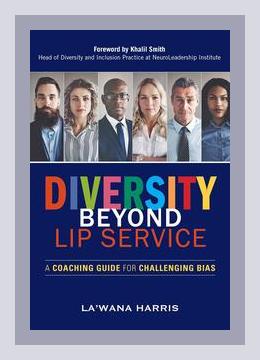Human Resources and Talent ManagementDiversity and Inclusion
Title: Diversity Beyond Lip Service: A Coaching Guide for Challenging Bias
Author: La’Wana Harris
Publication Year: 2019
Categories: Diversity and Inclusion
Summary:
Introduction:
La’Wana Harris’s “Diversity Beyond Lip Service: A Coaching Guide for Challenging Bias” addresses the necessity of moving beyond superficial commitments to diversity and inclusion. The book presents a practical approach for individuals and organizations to recognize, challenge, and overcome biases. Harris integrates her extensive experience as a coach with robust, actionable strategies, providing a comprehensive guide for enhancing inclusivity.
1. Understanding Bias and Its Impact:
Harris emphasizes the need for a deep understanding of what bias is and how it functions. Bias is often ingrained and operates unconsciously, impacting decision-making and behavior in subtle ways.
Example: Harris discusses a case where a highly qualified female leader consistently received feedback that she was “too aggressive.” This biased feedback stemmed from gender stereotypes influencing perceptions of leadership styles.
Action: Engage in self-awareness exercises to identify personal biases. This could include journaling about reflexive thoughts and feelings when interacting with diverse individuals or groups.
2. The Role of Authentic Leadership:
The book underscores the critical role of authentic leadership in fostering an inclusive culture. Authentic leaders exemplify transparency, vulnerability, and integrity, promoting trust and openness.
Example: A CEO publicly shared his journey of recognizing and addressing his own biases. This act of vulnerability set a tone of acceptance and openness throughout the organization.
Action: Lead by example; share personal stories of confronting biases and encourage others to do the same in a safe and supportive environment.
3. Creating Psychological Safety:
Psychological safety is a cornerstone of an inclusive environment. It ensures that all team members feel safe to express their thoughts and concerns without fear of retribution.
Example: Harris recounts a workshop where participants were initially reluctant to speak up about bias but gradually opened up as the facilitator consistently reinforced a judgment-free space.
Action: Implement regular forums for open discussion, and actively listen to team members’ input, reinforcing the idea that all perspectives are valuable and respected.
4. Practical Coaching Strategies:
The book delves into specific coaching methodologies aimed at addressing and mitigating biases. These include powerful questioning techniques, active listening, and empathy.
Example: A manager used the “Ladder of Inference” tool to guide a team member from making unexamined assumptions to drawing more rational conclusions based on observed data.
Action: Practice using coaching tools like the “Ladder of Inference” to help individuals critically examine their thought processes and challenge unfounded assumptions.
5. Recognizing and Interrupting Microaggressions:
Microaggressions, though often subtle, can have a profound impact on the targeted individuals’ sense of belonging and well-being.
Example: Harris narrates an incident where an African American employee was repeatedly asked where they were “really” from. This question, though seemingly innocuous, implied that the employee did not belong.
Action: Educate yourself and your team about microaggressions. When witnessed, address them immediately and explain why they are harmful.
6. Building Inclusive Policies and Practices:
The implementation of inclusive policies and practices is imperative for sustaining diversity and inclusion initiatives. This extends to recruitment, retention, and professional development.
Example: A company revised its hiring practices to include diverse panels and standardized interview questions to mitigate implicit bias.
Action: Review and revise organizational policies with a critical eye to identify and eliminate ingrained biases. Establish clear guidelines and accountability measures.
7. Accountability and Metrics:
Harris highlights the importance of setting measurable goals and holding individuals and organizations accountable for progress in diversity and inclusion efforts.
Example: An organization developed a quarterly inclusion scorecard that tracked various metrics such as employee satisfaction, diversity in leadership, and participation in inclusion training.
Action: Create specific, measurable, achievable, relevant, and time-bound (SMART) goals for diversity and inclusion efforts, and regularly review progress against these goals.
8. Developing Allyship:
Being an ally involves more than passive support; it requires active engagement and advocacy for marginalized groups.
Example: An executive sponsored an employee resource group (ERG) and used their influence to amplify the voices and concerns of underrepresented employees in leadership meetings.
Action: Take proactive steps to support marginalized colleagues, such as mentoring, sponsoring, or advocating for their professional growth and inclusion in decision-making processes.
9. Engaging in Difficult Conversations:
The book emphasizes the necessity of having difficult conversations about race, gender, and other sensitive topics to advance inclusion.
Example: A team held a series of facilitated discussions about racial bias following a controversial incident, which helped to build understanding and generate actionable solutions.
Action: Organize structured conversations on challenging topics, providing a respectful and open space for dialogue, and ensure that any actions arising from these conversations are diligently followed up.
10. Continuing Personal and Organizational Growth:
Diversity and inclusion is a continuous journey that requires commitment to ongoing learning and development.
Example: Harris shares her practice of engaging with diverse perspectives through books, podcasts, and workshops, thus broadening her understanding and empathy.
Action: Commit to continuous learning by setting aside time for reading, attending workshops, and engaging with a diverse range of voices and perspectives regularly.
Conclusion:
“Diversity Beyond Lip Service” is more than a philosophical treatise; it is a hands-on guide for effecting real change. La’Wana Harris equips readers with the tools needed to recognize, challenge, and overcome biases, thereby fostering truly inclusive environments. By translating insights into concrete actions, individuals and organizations can transcend mere performative diversity and cultivate authentic inclusion.
Human Resources and Talent ManagementDiversity and Inclusion
